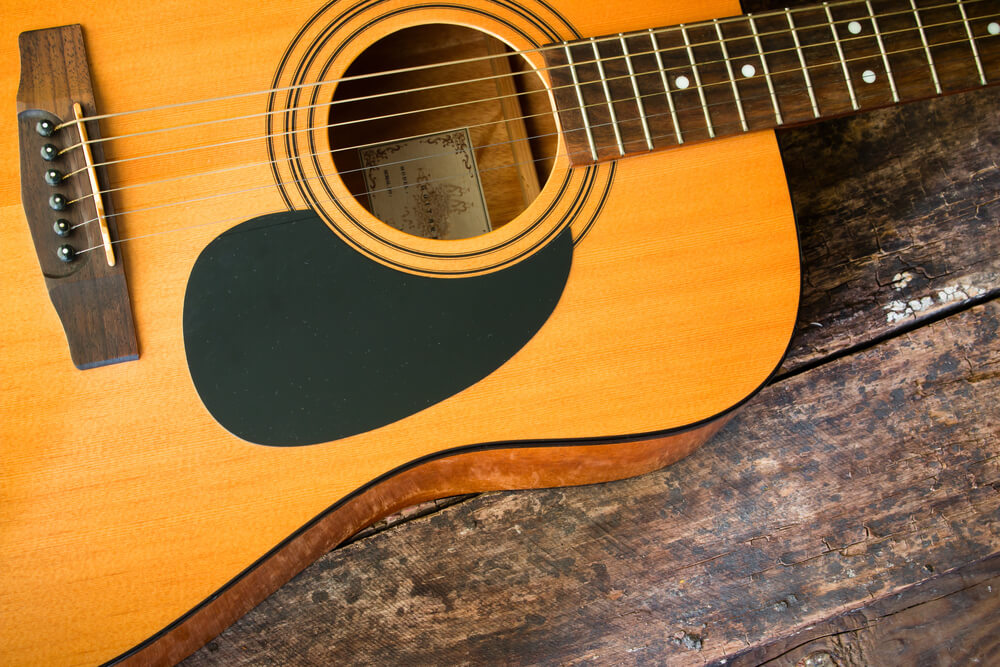When it comes to acoustic guitars, people often focus on factors like tonality, playability, and appearance.
However, How Heavy is an Acoustic Guitar? The weight of the instrument is an important aspect that should not be overlooked.
As a musician, knowing the weight of your guitar can help you select the right instrument for your needs, as it can have a significant impact on your playing comfort and style.
Acoustic guitars can vary in weight due to several factors, including the type and size of the guitar, the materials used in construction, and the presence of additional hardware or electronics.
Understanding these factors and their impact on the guitar’s weight will help you make a more informed decision when purchasing or handling an acoustic guitar.
Key Takeaways
- Acoustic guitar weight is influenced by factors such as size, materials, and hardware.
- Comparing acoustic guitars to other types can help you find the right weight for your needs.
- The guitar’s weight can affect playability, comfort, and suitability for different music genres.
How Heavy is an Acoustic Guitar
I believe it’s important to understand the basic elements of an acoustic guitar before discussing its weight. The design of an acoustic guitar consists of several components that contribute to its overall mass.
The primary parts include the body, neck, and headstock.
The body of an acoustic guitar is what gives it its distinct shape and sound. It is hollow and typically made of wood, which noticeably affects the weight of the instrument.
Different types of wood can be used, such as spruce, mahogany, and rosewood, each having its unique characteristics and weight impact.
The body is also comprised of a soundboard, back, and sides, all of which are essential for the resonance and projection of the guitar’s sound.
In addition to the body, the neck and headstock play critical roles in the construction of an acoustic guitar. The neck not only influences the guitar’s playability but also adds to its overall weight.
It is commonly made of mahogany or maple and is attached to the body either using glue or a bolt-on design. The headstock is situated at the top of the neck and holds the tuning pegs, which are responsible for maintaining the string tension and tuning of the guitar.
The shape of an acoustic guitar also plays a role in its weight. Guitars come in various sizes and shapes, each providing players with different tonal and ergonomic experiences.
Some common acoustic guitar shapes include dreadnought, concert, grand auditorium, and parlor guitars. These different shapes contribute to the instrument’s overall mass and can help determine the suitability of a particular guitar for a player’s needs.
To summarize, the weight of an acoustic guitar is influenced by factors such as its design, body, wood, neck, and shape. The combination of these elements creates a unique instrument with its distinct sound, feel, and mass.
It’s essential to consider these factors when choosing the right acoustic guitar for your playing style and preferences.
Standard and Non-Standard Sizes
When looking at acoustic guitars, you’ll notice a variety of sizes that can impact the overall weight of the instrument. Generally, there are two main categories: standard and non-standard sizes. To help you get a better understanding of these types, I’ll discuss them more in-depth.
In terms of standard-bodied acoustic guitars, they usually have a “regular” size and a “mini” size. Regular-size acoustic guitars are the most common type you’ll encounter.
They tend to have a balanced tone and are comfortable for average-sized individuals to play. On the other hand, mini acoustic guitars are smaller, with compact bodies and shorter scale lengths.
They’re great for smaller players, children, or for those looking for a portable guitar option.
Non-standard sizes can range from smaller, travel-sized guitars to larger, jumbo-sized guitars. For instance, a full-scale travel guitar is a popular choice for musicians on the go.
These guitars maintain a full-scale length while slimming down the body size, making them easy to transport without sacrificing playability.
To put the sizes in perspective, here are some approximate dimensions for a few standard and non-standard acoustic guitar sizes:
| Type | Body Length (inches) | Body Width (inches) | Body Depth (inches) |
|---|---|---|---|
| Regular Size Acoustic | 20 | 16 | 4.5 |
| Mini Acoustic | 17 | 12.5 | 3.5 |
| Full-Scale Travel Guitar | 19 | 15 | 3.5 |
Keep in mind that within these categories, various types of acoustic guitars may have slight variations in size and weight. Different materials, brands, and construction methods can also influence a guitar’s heaviness.
In conclusion, the weight of an acoustic guitar is largely determined by its standard or non-standard size. Considering the size that suits your preferences and playing needs will help you choose the best acoustic guitar for you.
Weight of Different Types of Acoustic Guitars
The weight of an acoustic guitar can vary significantly depending on the shape and size of the instrument.
In this section, I will discuss the weight of various types of acoustic guitars, including jumbo, grand jumbo, dreadnought, parlor, concert, auditorium, and grand concert guitars.
Jumbo and Grand Jumbo Guitars: Jumbo and grand jumbo guitars are the largest and heaviest among the acoustic guitar family. These guitars typically weigh between 4.5 to 6 pounds. The increased size and weight contribute to a powerful and robust sound, making them popular for rhythm guitarists.
Dreadnought Guitars: Dreadnought guitars are a popular choice among guitarists due to their versatility and rich sound. These guitars generally weigh between 3.5 to 5 pounds. The slightly smaller body size compared to jumbo and grand jumbo guitars contributes to their moderate weight.
Parlor Guitars: Parlor guitars are known for their compact size and lightweight construction. They usually weigh between 2.5 to 3.5 pounds. These guitars produce a more focused tone and are great for fingerpicking and solo performances.
Concert and Grand Concert Guitars: Concert and grand concert guitars are characterized by their balanced tone and comfortable playing experience. The concert model typically weighs around 3 to 4 pounds, while the grand concert model ranges from 3.5 to 4.5 pounds. These guitars are suitable for various playing styles, including strumming and fingerpicking.
Auditorium and Grand Auditorium Guitars: Auditorium and grand auditorium guitars feature a curvier shape that feels comfortable to hold and play. The auditorium model typically has a weight range of 3 to 4 pounds, while the grand auditorium varies between 3.5 to 5 pounds. These guitars produce a well-balanced tone suited for both strumming and fingerstyle playing.
In summary, acoustic guitar weights can vary significantly based on the type and size of the guitar. Larger models, such as jumbo and grand jumbo guitars, are on the heavier side, while smaller models, like parlor guitars, are lighter.
Concert, auditorium, and dreadnought guitars offer a versatile range of weights to accommodate different playing styles and preferences.
Materials and Build Quality
As a guitarist, I find that the materials and build quality greatly influence the weight of an acoustic guitar. The woods used for the body, neck, and top play a significant role in determining both the overall tone and the weight.
Commonly used guitar body woods include koa, mahogany, maple, and rosewood. For the top, manufacturers often use Sitka spruce, red spruce, and Indian rosewood.
In my experience, guitars from companies like Martin, Gibson, Fender, Yamaha, Taylor, Epiphone, and Fishman exhibit high-quality craftsmanship.
While the specific woods used can vary between models, I’ve noticed that Martin and Taylor guitars lean towards using mahogany, Gibson, and Epiphone often prefer maple, and Yamaha tends to employ a mix of multiple hardwoods.
Mahogany is typically lighter in weight, while maple is denser, resulting in a heavier guitar.
It’s essential to note the difference between solid top and laminate guitars. Solid top guitars use a single piece of wood for the top, whereas laminate guitars use multiple layers of wood pressed together.
Generally, I’ve found that laminate guitars are more affordable but heavier than their solid top counterparts due to the extra amount of wood used in the construction.
The type of finish on an acoustic guitar also contributes to its overall weight. Guitars with thick, high-gloss finishes tend to be denser and heavier than those with thin, satin finishes.
Brands such as Martin, Gibson, and Taylor provide options for both high-gloss and satin finishes.
In conclusion, acoustic guitar weight depends on multiple factors, including the type of wood used, build quality, finish, and whether it’s a solid top or laminate construction.
As a guitarist, I suggest seeking guitars from reputable companies like Martin, Gibson, Yamaha, and Taylor, as they often prioritize high-quality materials and craftsmanship to ensure enjoyable playing experiences.
Additional Hardware and Electronics
When it comes to the weight of an acoustic guitar, additional hardware and electronics can also contribute. I’ll discuss some of the key components that might add weight to the guitar.
First, let’s consider the fretboard. The fretboard is usually made of hardwood, such as rosewood or ebony, which can be denser than the wood used for the rest of the guitar.
The weight of the fretboard could impact the overall weight of the guitar, especially if inlaid with heavier materials such as mother-of-pearl.
Now, let’s discuss pickups. Although acoustic guitars primarily rely on their soundhole to project sound, some models include built-in pickups for amplification.
These pickups are usually mounted underneath the saddle or in the soundhole and can add weight to the guitar. The addition of a preamp system for controlling volume and tone or the incorporation of an onboard tuner can also increase the weight.
Onto electric and bass guitars, while these instruments don’t have the hollow body design of an acoustic guitar, they have more hardware and electronics.
An electric guitar’s solid body is constructed from heavier materials, and the numerous electronic components (pickups, switches, and pots) can contribute to their overall heavier weight.
Similarly, a bass guitar, with its heavier strings and larger body, can weigh more than an acoustic guitar.
Lastly, it’s important to consider the hardware attached to the guitar. This can include tuners, strap buttons, and bridge pins, which can be made from heavy materials like metal or brass.
Upgraded hardware options, like locking tuners or ornate bridge pins, may also contribute to a heavier guitar.
Taking all of these factors into account, it’s clear that additional hardware and electronics can have an impact on the overall weight of an acoustic guitar. However, the precise weight difference will vary depending on the specific materials and components used in each guitar.
Comparing Acoustic to Other Guitars
When it comes to the weight of guitars, there is a considerable difference between acoustic guitars and their electric counterparts. While an acoustic guitar generally weighs around 4.5 to 5 pounds, electric guitars have varying weights depending on their construction and design.
For instance, solid-body electric guitars like the Fender Stratocaster or the Gibson Les Paul often weigh between 8 and 10 pounds. Their weight can be attributed to the solid wood construction and the hardware they contain, such as the pickups and tuning pegs.
Hollow-body electric guitars, on the other hand, tend to be lighter due to their hollow construction, which allows for the resonance of sound without the need for electronic amplification.
A vintage acoustic guitar might appear heavier than its modern counterpart due to the different woods used in its construction or variations in its manufacturing.
However, the weight difference is not significant enough to impact its playability.
Classical guitars, which typically use nylon strings, are usually lighter than acoustic guitars with steel strings. Their unique bracing and smaller bodies contribute to their lighter weight. The difference in weight is marginal, about 3.5 to 4.5 pounds.
Bass guitars, especially those with a solid body, are on the heavier side of the spectrum compared to acoustic guitars. A typical bass guitar may weigh anywhere from 9 to 12 pounds, depending on the materials used, pickups, and hardware.
Tenor guitars, designed for playing rhythm guitar parts, have a smaller body and a shorter scale length than a standard acoustic guitar. This compact size generally results in a lighter guitar, with an average weight of around 3 to 4 pounds.
The weight of an acoustic guitar, such as the Gibson J-45, may be heavier than its Squier counterpart, which is an entry-level guitar.
Higher-grade materials, hardware, and construction techniques can contribute to the weight disparity between these guitars, but it’s worth noting that a heavier weight does not always translate to better quality.
In conclusion, acoustic guitars are generally lighter than most electric, bass, and vintage guitars, but weight has little correlation to the quality, tone, or playability of a guitar.
Adopting a confident and knowledgeable approach when choosing a guitar based on its weight can greatly contribute to enhancing one’s playing experience.
Weight in Relation to Playability and Comfort
When it comes to playability and comfort, the weight of an acoustic guitar can make a significant difference.
I’ve found that lighter guitars can be more comfortable to play for extended periods, especially for those who prefer fingerstyle playing or frequently practice strumming.
The guitar body plays a significant role in determining the overall weight of an acoustic guitar. There are various body types, and each has its impact on comfort and playability.
I’ve noticed that smaller-bodied guitars like parlor or concert models tend to be lighter and easier to hold, whereas jumbo or dreadnought guitars might be heavier but provide more resonance and projection.
Another factor to consider is the type of guitar strings used. Lightweight strings, like those made from nylon, often require less tension to be pressed down by the fingers.
In contrast, steel strings might require more finger pressure, which could lead to hand fatigue after extended playing sessions.
Ultimately, the choice of strings depends on personal preference, as some players might find that steel strings provide a brighter and more dynamic sound worth the trade-off in finger discomfort.
I’ve also learned that the fingerpicking technique can influence the comfort of playing a guitar. Fingerstyle playing usually involves fewer strings, which could allow the player to choose a lighter guitar and maintain the strings’ tension at a comfortable level.
On the other hand, strumming with a pick or using more aggressive picking techniques can generate more force on the strings, potentially requiring a heavier guitar to provide stability and better sound projection.
Considering the different body types and playing styles, it’s essential to find a lightweight guitar that suits one’s preferences and physical attributes.
By doing so, the overall comfort and playability of the instrument can be significantly improved, allowing for more enjoyable and prolonged playing sessions.
Acoustic Guitar Weight in Different Musical Genres
In my experience playing acoustic guitars across various genres, I’ve noticed that the weight of these instruments can vary depending on the style of music.
Let’s explore how the weight of an acoustic guitar relates to playing genres like rock, folk, blues, and country.
Rock: Acoustic guitars used in rock music often feature a larger body and heavier construction to provide a rich, full sound. These instruments may weigh more due to their denser tonewoods or heavier bracing systems. A perfect example is the Gibson Hummingbird, which typically weighs around 5 lbs.
Folk: Folk musicians often prefer lighter guitars for ease of playing and portability. The concert and auditorium-style guitars are popular choices for folk artists. They are lighter and more comfortable to hold for extended periods. A well-known folk guitar, the Martin 000-15M, weighs around 4 lbs.
Blues: Blues acoustic guitarists tend to use guitars that produce a distinct, warm, and expressive tone. Acoustic guitars in this genre usually feature a smaller body, which results in a lighter weight. A popular choice amongst blues players is the Gibson L-1, which can weigh around 3.5 lbs.
Country: Country musicians typically use acoustic guitars with a balanced and bright sound, with a focus on projection and resonance. This often results in a guitar with a larger body, but it still maintains a manageable weight. The Martin D-28, a popular choice for country artists, weighs around 4.5 lbs.
The weight of an acoustic guitar varies by the style of music it is intended for. As a musician, it’s essential to find the perfect balance between the tone, playability, and weight for your desired genre.
Choosing the Right Weight for You
When it comes to selecting the ideal acoustic guitar, weight is an important factor that should not be overlooked. As a player, I understand that personal preference plays a significant role in making this decision.
The right weight affects both practice and performance, allowing for comfortable and effortless playing.
For those on a budget, consider the Taylor GS Mini, which is a great lightweight alternative to a full-sized guitar. The reduced size and weight make it a popular choice for players seeking a travel guitar without compromising on sound quality.
Carrying it around is easy, as a gig bag is usually sufficient for protection during transit.
Considering the pros and cons of various guitar weights is crucial. Lighter guitars like the Taylor GS Mini tend to provide tuning stability, making them ideal for long practice sessions or live performances.
The reduced weight can also be a boon for younger or smaller players who may struggle with the heftier bulk of a full-sized instrument.
Nevertheless, heavier guitars often produce a fuller and richer tone, which may be essential for certain styles or genres. Prioritize what truly matters in your instrument, whether it be the comfort of playing or the tonal quality that can only be achieved with a more substantial guitar.
Remember, ultimately, it’s your playing experience that matters the most. Be mindful of your practice and performance needs, as well as your budget.
Evaluating these factors will help you make an informed decision when choosing the perfect acoustic guitar weight for you.
Conclusion
In my experience, the weight of an acoustic guitar can vary depending on the different materials used and its overall construction. On average, most acoustic guitars weigh between 2.5 and 5 kilograms (5.5 to 11 pounds).
The type of wood used in the body, neck, and fretboard can significantly influence its weight.
For instance, a guitar made primarily from mahogany is generally heavier than one made from spruce or cedar. This difference in weight can impact the tone and resonance of the instrument, with heavier guitars often producing warmer, richer sounds.
When considering the weight of an acoustic guitar, it’s crucial to strike a balance between tonal quality and playability.
My personal preference leans toward lighter guitars, as they tend to be more comfortable to play for extended periods. A lighter guitar can also make it easier for beginners to pick up and learn the instrument.
Yet, it’s essential to remember that each individual has unique preferences, and what works for one person may not necessarily work for another.
In conclusion, the weight of an acoustic guitar is an essential factor to consider when selecting an instrument that suits your needs and preferences.
By understanding the impact of the guitar’s materials, construction, and tone on its overall weight, you’ll be better equipped to find the perfect guitar for your musical journey.
Frequently Asked Questions
What is the typical weight range for acoustic guitars?
The weight of an acoustic guitar usually ranges between 3.5 and 5 pounds, with the average being around 4.5 pounds. This weight varies due to differences in wood materials, size, and other factors that affect the construction of the instrument.
How do guitar sizes affect their weight?
There are several sizes of acoustic guitars, such as dreadnought, concert, and parlor. Generally, larger guitars weigh more than smaller ones.
For example, a dreadnought guitar typically weighs more than a parlor guitar due to its larger body and deeper depth. Smaller guitars, like the concert and parlor, usually weigh less than their larger counterparts but can still vary depending on the materials used in their construction.
How do wood types influence acoustic guitar weight?
The type of wood used in the construction of an acoustic guitar has a direct impact on its weight. Dense wood species like rosewood and mahogany generally make for a heavier guitar, while woods like spruce and cedar are lighter.
Further, some manufacturers may use laminated wood, which can also affect the weight of the instrument.
What factors can impact the weight of an acoustic guitar?
Besides size and wood type, other factors can influence the weight of an acoustic guitar. These include the type of bracing used in the guitar’s construction, the thickness of the wood panels, hardware components (such as tuners and bridge pins), and the presence of electronics or a built-in pickup system.
Heavier bracing, thicker panels, and additional hardware can all contribute to increased weight.
How does the weight of an acoustic guitar compare to electric and bass guitars?
In general, acoustic guitars tend to be lighter than electric and bass guitars. Electric guitars tend to weigh around 6 to 10 pounds, while bass guitars can weigh from 7 to 11 pounds.
These weights are primarily due to the components used, such as the solid-body design, electronics, and hardware needed for an electric or bass guitar.
Are heavier or lighter acoustic guitars better for beginners?
There isn’t a definitive answer to this question, as it depends on the individual’s preferences and comfort level. Some beginners might prefer a lighter guitar for ease of handling and reduced fatigue during extended play, while others might find a heavier guitar more stable and comfortable.
Ultimately, the best choice is to try different guitars and determine which one feels most comfortable and suited to your style of playing.








